Protocarnivorous plant
A protocarnivorous plant (sometimes also paracarnivorous, subcarnivorous, or borderline carnivore), according to some definitions, traps and kills insects or other animals but lacks the ability to either directly digest or absorb nutrients from its prey like a carnivorous plant. The morphological adaptations such as sticky trichomes or pitfall traps of protocarnivorous plants parallel the trap structures of confirmed carnivorous plants.
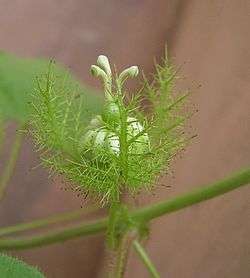
Some authors prefer the term "protocarnivorous" because it implies that these plants are on the evolutionary path to true carnivory, whereas others oppose the term for the same reason. The same problem arises with "subcarnivorous". Donald Schnell, author of the book Carnivorous Plants of the United States and Canada, prefers the term "paracarnivorous" for a less rigid definition of carnivory that can include many of the possible carnivorous plants.[1]
The demarcation between carnivorous and protocarnivorous is blurred by the lack of a strict definition of botanical carnivory and ambiguous academic literature on the subject. Many examples of protocarnivorous plants exist, some of which are counted among the ranks of true carnivorous plants as a matter of historical preference. Further research into these plants' carnivorous adaptations may reveal that a few protocarnivorous plants do meet the more rigid definition of a carnivorous plant.
Historical observations
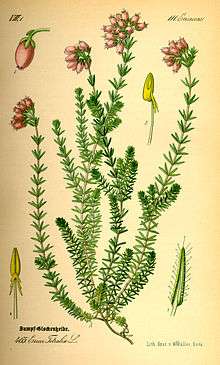
Historical observations of the carnivorous syndrome in plant species have been restricted to the more obvious examples of carnivory, such as the active trapping mechanisms of Drosera (the sundews) and Dionaea (Venus flytrap), though authors have often noted speculation about other species that may not be so obviously carnivorous. In one of the earlier publications on carnivorous plants, Charles Darwin had suggested many plants that have developed adhesive glands, such as Erica tetralix, Mirabilis longifolia, Pelargonium zonale, Primula sinesis, and Saxifraga umbrosa, may indeed be carnivorous but little research has been done on them. Darwin himself only mentioned these species in passing and did not follow through with any investigation.[2][3] Adding to the small but growing list, Francis Lloyd provided his own list of species suspected of carnivory in his 1942 book on carnivorous plants, though these species and their potential were only mentioned in the introduction.[4] Later, in a 1981 review of the literature, Paul Simons rediscovered Italian journal articles from the early 1900s that identified several additional sticky species that digested insect prey. Simons was surprised to find these articles lacking in the literature cited sections of many modern books and articles on carnivorous plants, suggesting that academic research has treated Lloyd's 1942 book as the authoritative and comprehensive source on pre-1942 research on the carnivorous syndrome.[5]
Defining carnivory
Debate about what criteria a plant must meet to be considered carnivorous has yielded two proposed definitions: one with strict requirements and the other less restrictive.
The strict definition requires that a plant must possess morphological adaptations that attract prey through scent or visual cues, capture and retain prey (e.g., the waxy scales of Brocchinia reducta or downward facing hairs of Heliamphora prevent escape), digest the dead prey through enzymes produced by the plant, and absorb the products of digestion through specialized structures. The presence of commensals is also listed as strong evidence of a long evolutionary history of carnivory.[6] By this definition, many sun pitcher plants (Heliamphora)[7] and the cobra lily (Darlingtonia californica)[8] would not be included on a roster of carnivorous plants because they rely on symbiotic bacteria and other organisms to produce the necessary proteolytic enzymes.
The broader definition differs mainly in including plants that do not produce their own digestive enzymes but rely on internal food webs or microbes to digest prey, such as Darlingtonia and some species of Heliamphora. The original definition of botanical carnivory, set out in Givnish et. al. (1984),[9] required a plant to exhibit an adaptation of some trait specifically for the attraction, capture, or digestion of prey while gaining a fitness advantage through the absorption of nutrients derived from said prey. Upon further analysis of genera currently considered carnivorous, botanists widened the original definition to include species that use mutualistic interactions for digestion.
Both the strict and broad definitions require absorption of the digested nutrients. The plant must receive some benefit from the carnivorous syndrome; that is, the plant must display some increase in fitness because of the nutrients obtained from its carnivorous adaptations. Increased fitness might mean improved growth rate, increased chance of survival, higher pollen production or seed set.[9]
Degrees of carnivory
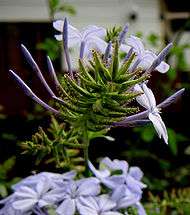
One prevailing idea is that carnivory in plants is not a black and white duality, but rather a spectrum from strict non-carnivorous photoautotrophs (a rose, for example) to fully carnivorous plants with active trapping mechanisms like those of Dionaea or Aldrovanda. However, passive traps are still considered fully carnivorous. Plants that fall between the definitions in the strict carnivorous/non-carnivorous demarcation can be defined as being protocarnivorous.
It is thought that these plants that have evolved protocarnivorous habits typically reside in habitats where there is a significant nutrient deficiency, but not the severe deficiency in nitrogen and phosphorus seen where true carnivorous plants grow.[10] The function of the protocarnivorous habit, however, need not be directly related to lack of nutrient access. Some classic protocarnivorous plants represent convergent evolution in form but not necessarily in function. Plumbago, for example, possesses glandular trichomes on its calyces that structurally resemble the tentacles of Drosera and Drosophyllum.[11] The function of the Plumbago tentacles is, however, disputed. Some contend that their function is to aid in pollination, adhering seeds to visiting pollinators.[12] Others note that on some species (Plumbago auriculata), small, crawling insects have been trapped in the Plumbago's mucilage, which supports the conclusion that these tentacles could have evolved to exclude crawling insects and favor flying pollinators for greater seed dispersal or perhaps for protection against crawling insect predators.[11]
Trapping mechanisms
There are visible parallels between the trapping mechanisms of carnivorous plants and protocarnivorous plants. Plumbago and other species with glandular trichomes resemble the flypaper traps of Drosera and Drosophyllum. The pitfall traps of protocarnivorous plants, such as some Heliamphora species and Darlingtonia californica, are so similar to those of true carnivorous plants that the only reason they may be considered protocarnivorous instead of carnivorous is that they do not produce their own digestive enzymes. There are also protocarnivorous bromeliads that form a pitfall trap in an "urn" of rosetted leaves that are held together tightly. There are also other plants that produce a sticky mucilage not necessarily associated with a tentacle or glandular trichome, but instead can be described more like a slime capable of trapping and killing insects.
Flypaper traps
Dr. George Spomer of the University of Idaho has discovered protocarnivorous activity and function in several glandular plant species, including Cerastium arvense, Ipomopsis aggregata, Heuchera cylindrica, Mimulus lewisii, Penstemon attenuata, Penstemon diphyllus, Potentilla glandulosa var. intermedia, Ribes cereum, Rosa nutkana var. hispida, Rosa woodsii var. ultramontana, Solanum tuberosum, Stellaria americana, and Stellaria jamesiana. These species tested positive for protease activity, though it is unclear whether the protease is produced by the plant or by surface microbes. Two other species evaluated by Dr. Spomer, Geranium viscosissimum and Potentilla arguta, exhibited protease activity and were further examined with 14C-labeled algal protein for nutrient absorption activity. Both of these latter species displayed an ability to digest and absorb the labeled protein.[13]
Other plants that are considered to be protocarnivorous have sticky trichomes on some surface, such as the flower scape and bud of Stylidium and Plumbago,[14] the bracts of Passiflora foetida, and leaves of Roridula. The trichomes of Stylidium, which appear below the flower, have been known to trap and kill small insects since their discovery several centuries ago, but their purpose remained ambiguous. In November 2006, Dr. Douglas Darnowski published a paper describing the active digestion of proteins when they come in contact with a trichome of a Stylidium species grown in aseptic tissue culture, proving that the plant, rather than the surface microbes, was the source of protease production.[15] Darnowski asserts in that paper that given this evidence, Stylidium species are properly called carnivorous, though in order to fulfill the strict definition of carnivory it needs to be proven that they are capable of absorbing nutrients derived from prey and that this adaptation gives the plants some competitive advantage.
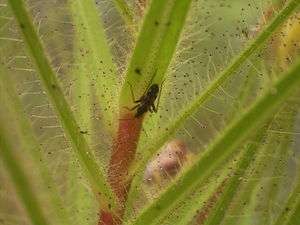
Roridula has a more complex relationship with its prey. The plants in this genus produce sticky leaves with resin-tipped glands that look similar to those of larger Drosera. However, the resin, unlike mucilage, is unable to carry digestive enzymes. Therefore, Roridula species do not directly benefit from the insects they catch. Instead, they form a mutualistic symbiosis with species of assassin bugs that eat the trapped insects. The plant benefits from the nutrients in the bugs' feces.[16]
Likewise, the sticky, modified bracts of Passiflora foetida have been investigated for their carnivorous ability. A 1995 paper published in the Journal of Biosciences detailed the evidence that the glandular bracts played a distinct role in defense of the flower and were also capable of digesting captured prey and absorbing the nutrients.[17]
Ibicella lutea is another flypaper protocarnivore that has been the subject of several studies. Early studies concluded that the plant digested proteinaceous offerings, though the methods were crude.[18] Subsequent studies done more carefully tested for the presence of protease activity and found none, though it was noted that the plant has a great capacity for capturing and killing prey.[19]
Pitfall traps
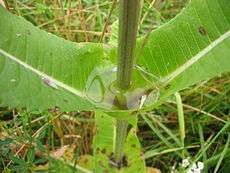
The pitfall traps of protocarnivorous plants are identical to those of carnivorous plants in every way except in the plant's mode of digestion. The rigid definition of carnivory in plants requires digestion of prey by enzymes produced by the plant. Given this criterion, many of the pitfall trap plants commonly considered to be carnivorous would instead be classified as protocarnivorous. However, this is highly contentious and generally not reflected in current carnivorous plant phylogenies or literature.[20][21] Darlingtonia californica[8] and several Heliamphora species do not produce their own enzymes, relying instead on an internal food web to break down the prey into absorbable nutrients.[7]
Another pitfall trap form unrelated to the Sarraceniaceae family are the urns of bromeliad leaves that are formed when leaves are tightly packed together in a rosette, collecting water and trapping insects. Unlike Brocchinia reducta, which has been proven to produce at least one digestive enzyme and can therefore be considered carnivorous, the epiphytic Catopsis berteroniana has little evidence supporting the claims that it is carnivorous. It is able to attract and kill prey and the trichomes on the surface of the leaves can absorb nutrients, but so far no enzyme activity has been detected. It may be that this plant also relies on an internal food web for soft tissue digestion.[22] The same could be said for Paepalanthus bromelioides, though it is a member of Eriocaulaceae and not a bromeliad. It also forms a central water reservoir that has adaptations to attract insects. It, like C. berteroniana, produces no digestive enzymes.[23]
Another potential protocarnivorous pitfall trap is a species of teasel, Dipsacus fullonum, which has been only suggested as a possible carnivore. Only one major study has examined D. fullonum for carnivory and no evidence of digestive enzymes or foliar nutrient absorption was revealed.[24]
Other
Capsella bursa-pastoris, shepherd's purse, is another plant where the claim of carnivory is contested. This unique protocarnivorous plant is only capable of capturing prey during one stage of its life cycle. The seeds of the plant, when moistened, secrete a viscous fluid that actively attracts and kills prey. There is also evidence of protease activity and absorption of nutrients.[25] The only carnivory criterion not explored is how much the plant benefits from the carnivorous adaptation.[1]
Loss of carnivory
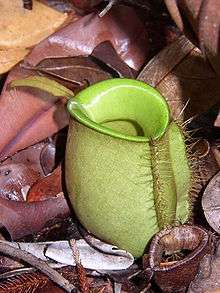
A few plants that could be considered protocarnivorous or paracarnivorous are those that once had carnivorous adaptations but appear to be evolving or have evolved away from a direct prey relationship with arthropods and rely on other sources for obtaining nutrients. One example of such a phenomenon is the pitfall trap of Nepenthes ampullaria, a tropical pitcher plant. Although it retains its ability to attract, capture, kill, and digest insect prey, this species has acquired adaptations that appear to favor digestion of leaf litter. It could potentially be referred to as a detritivore.[26] Another tropical pitcher plant, Nepenthes lowii, is known to catch very few prey items compared to other Nepenthes.[27] Preliminary observations suggest that this particular species may have moved away from a solely (or even primarily) carnivorous nature and be adapted to "catching" the droppings of birds feeding at its nectaries.[26][28] A 2009 study found that mature N. lowii plants derived 57–100% of their foliar nitrogen from treeshrew droppings.[29][30]
Utricularia purpurea, a bladderwort, comes from another genus of carnivorous plants and may have lost its appetite for carnivory, at least in part. This species can still trap and digest arthropod prey in its specialized bladder traps, but does so sparingly. Instead, it harbors a community of algae, zooplankton, and debris in the bladders, giving rise to the hypothesis that the bladders of U. purpurea favor a mutualistic interaction in place of a predator-prey relationship.[31]
Evolution
The disciplines of ecology and evolutionary biology have presented several hypotheses on the evolution of carnivorous plants that may also apply to protocarnivorous plants. The name "protocarnivorous plant" itself suggests that these species are on their way to carnivory, though others may simply be an example of a defense-related adaptation, such as that found in Plumbago.[11][12] Still others (Utricularia purpurea, Nepenthes ampullaria, and Nepenthes lowii) may be examples of carnivorous plants moving away from the carnivorous syndrome.
In his 1998 book, Interrelationship Between Insects and Plants, Pierre Jolivet only considered four species of plants to be protocarnivorous: Catopsis berteroniana, Brocchinia reducta, B. hectioides, and Paepalanthus bromeloides. Jolivet writes, "It is important to remember that all carnivorous plants are dicots and all protocarnivorous plants are monocots," though he does not explain why nor does he describe his reasons for excluding other dicotyledonous plants that are protocarnivorous.[32]
Notes
- Schnell, 2002
- Darwin, 1875
- Roberts, Hattie R.; Warren, John M.; Provan, Jim (2018-07-04). "Evidence for facultative protocarnivory in Capsella bursa-pastoris seeds". Scientific Reports. 8 (1): 10120. Bibcode:2018NatSR...810120R. doi:10.1038/s41598-018-28564-x. ISSN 2045-2322. PMC 6031654. PMID 29973685.
- Lloyd, 1942
- Simons, 1981
- The five rigid criteria of the carnivorous syndrome proposed by Juniper et al. (1989) and Albert et al. (1992).
- Field studies of Heliamphora have determined that some species (H. nutans, H. heterodoxa, H. minor, and H. ionasi) do not produce their own digestive enzymes (Jaffe et al., 1992).
- Hepburn et al. (1927) is referenced in Ellison and Farnsworth (2005) as the authoritative source on Darlingtonia's apparent lack of proteolytic enzymes. Ellison and Farnsworth (2005) also notes that Darlingtonia instead relies on "a food web of bacteria, protozoa, mites, and fly larvae" to break down captured prey (Naeem, 1988; Nielsen, 1990).
- Givnish, T.J., Burkhardt, E.L., Happel, R.E., and Weintraub, J.D. (1984), "Carnivory in the bromeliad Brocchinia reducta, with a cost/benefit model for the general restriction of carnivorous plants to sunny, moist, nutrient-poor habitats", American Naturalist, 124 (4): 479–497, doi:10.1086/284289, JSTOR 2461590CS1 maint: multiple names: authors list (link)
- Spoomer (1999) presented the argument that carnivorous plants may have evolved from protocarnivorous species when faced with a nutrient deficiency, noting the genetic evidence for multiple independent plant lines that evolved a fully carnivorous habit (Juniper et al., 1989; Albert et al., 1992).
- Schlauer, 1997
- Fahn and Werker, 1972
- Spomer, 1999
- Rachmilevitz and Joel, 1976
- Darnowski et al., 2006
- Hartmeyer (1998) described this phenomenon in the genus Roridula.
- Passiflora foetida bracts produce proteases and acid phosphatases (Radhamani et al., 1995).
- Beal (1875) and Mameli (1916) both placed bits of food—beef and hard-boiled egg white, respectively—on the leaf surface and in some cases the food "disappeared." They concluded that Ibicella lutea may be carnivorous.
- Meyers-Rice (1999) and Wallace et al. (1999) completed the same studying using a similar methodology to test for protease activity in Ibicella lutea. They both concluded the plant possessed no protease enzymes.
- Givnish, T. J. (2015). "New evidence on the origin of carnivorous plants". PNAS. 112 (1): 10–11. Bibcode:2015PNAS..112...10G. doi:10.1073/pnas.1422278112. PMC 4291624. PMID 25538295.
- Pavlovic, A., Saganova, M. (2015). "A novel insight into the cost-benefit model for the evolution of botanical carnivory". Annals of Botany. 115 (7): 1075–1092. doi:10.1093/aob/mcv050. PMC 4648460. PMID 25948113.CS1 maint: multiple names: authors list (link)
- Frank and O'Meara (1984) detected a higher trapping rate in C. berteroniana compared to three other tank bromeliads. They also noted that commensals lived unharmed within the tank. Benzing et al. (1976) discovered that C. berteroniana is capable of absorbing radioisotope-tagged amino acids through the leaves.
- Pierre Jolivet (1998) suggests that this plant also relies on its internal food web to break down the soft tissues of prey for absorption.
- Christy (1923) did note that the fluid collected in the basin formed by the leaves has a lower surface tension, which could be an adaptation to kill prey.
- Barber, 1978
- Clarke, 2001
- Adam, 1997
- Clarke, 1997
- Clarke et al., 2009
- Fountain, 2009
- Richards (2001) did an extensive study in the field on U. purpurea and noted that trapping rates of the usual Utricularia prey were significantly lower than in other species in the genus.
- Jolivet, 1998
References
- Adam, J.H. (1997). "Prey spectra of Bornean Nepenthes species (Nepenthaceae) in relation to their habitat" (PDF). Pertanika Journal of Tropical Agricultural Science 20(2/3): 121–134.
- Albert, V.A.; Williams, S.E.; Chase, M.W. (1992). "Carnivorous plants: Phylogeny and structural evolution". Science. 257 (5076): 1491–1495. Bibcode:1992Sci...257.1491A. doi:10.1126/science.1523408. PMID 1523408.
- Barber, J.T. (1978). "Capsella bursa-pastoris seeds: Are they "carnivorous"?" (PDF). Carnivorous Plant Newsletter. 7: 39–42.
- Beal, W.J. (1875). "Carnivorous plants". Journal of the American Association for the Advancement of Science. 1875B: 251–253.
- Benzing, D.H.; Henderson, K.; Kessel, B.; Sulak, J.A. (1976). "The absorptive capacities of bromeliad trichomes". American Journal of Botany. 63 (7): 1009–1014. doi:10.2307/2441760. JSTOR 2441760.
- Christy, M (1923). "The common teazel as a carnivorous plant". Journal of Botany. 61: 33–45.
- Clarke, C.M. (1997). Nepenthes of Borneo. Natural History Publications (Borneo), Kota Kinabalu.
- Clarke, C.M. (2001). Nepenthes of Sumatra and Peninsular Malaysia. Natural History Publications (Borneo), Kota Kinabalu, pp. 59–60.
- Clarke, C.M.; Bauer, U.; Lee, C.C.; Tuen, A.A.; Rembold, K.; Moran, J.A. (2009). "Tree shrew lavatories: a novel nitrogen sequestration strategy in a tropical pitcher plant". Biology Letters. 5 (5): 632–635. doi:10.1098/rsbl.2009.0311. PMC 2781956. PMID 19515656.
- Darnowski, D.W.; Carroll, D.M.; Płachno, B.; Kabanoff, E.; Cinnamon, E. (2006). "Evidence of protocarnivory in triggerplants (Stylidium spp.; Stylidiaceae)". Plant Biology. 8 (6): 805–812. doi:10.1055/s-2006-924472. PMID 17058181.
- Darwin, Charles. (1875). Insectivorous Plants. J. Murray, London.
- Ellison, A.M.; Farnsworth, E.J. (2005). "The cost of carnivory for Darlingtonia californica (Sarraceniaceae): Evidence from relationships among leaf traits". American Journal of Botany. 92 (7): 1085–1093. doi:10.3732/ajb.92.7.1085. PMID 21646130.
- Fahn, A. and Werker, E. (1972). Anatomical mechanisms of seed dispersal. in Kozlowski, T.T. (ed.), Seed Biology, Academic Press.
- Frank, J.H.; O'Meara, G.F. (1984). "The bromeliad Catopsis berteroniana traps terrestrial arthropods but harbors Wyeomyia larvae (Diptera: Culicidae)". Florida Entomologist. 67 (3): 418–424. doi:10.2307/3494721. JSTOR 3494721.
- Fountain, H. 2009. A Plant That Thrives When Used as a Toilet. The New York Times, June 15, 2009.
- Hartmeyer, S. (1998). Carnivory in Byblis revisited II: The phenomenon of symbiosis on insect trapping plants. Carnivorous Plant Newsletter, 27(4): 110–113. Available online: HTML
- Hepburn, J.S.; Saint John, E.Q.; Jones, E.M. (1927). "The biochemistry of the American pitcher plants". Transactions of the Wagner Free Institute of Science of Philadelphia. 11: 1–95.
- Jaffe, K., Michelangeli, F., Gonzalez, J.M., Miras, B., and Ruiz, M.C. (1992). Carnivory in Pitcher Plants of the Genus Heliamphora (Sarraceniaceae). New Phytologist, 122(4): 733–744. (First page available online: JSTOR PDF of first page and HTML text of abstract)
- Jolivet, Pierre. (1998). The Interrelation Between Insects and Plants, CRC Press.
- Juniper, B.E., Robbins, R.J., and Joel, D.M. (1989). The Carnivorous Plants. London: Academic Press. ISBN 0-12-392170-8
- Lloyd, F.E. (1942). The Carnivorous Plants. New York: The Ronald Press Company.
- Mameli, E. (1916). Ricerche anatomiche, fisiologiche e biologiche sulla Martynia lutea Lindl. Atti del'Universita di Pavia (Serie 2) 16: 137–188.
- Meyers-Rice, B.A. (1999). Testing the appetites of Ibicella lutea and Drosophyllum. Carnivorous Plant Newsletter, 28: 40–43. Available online: HTML
- Naeem, S (1988). "Resource heterogeneity fosters coexistence of a mite and a midge in pitcher plants". Ecological Monographs. 58 (3): 215–227. doi:10.2307/2937026. JSTOR 2937026.
- Nielsen, D.W. (1990). "Arthropod communities associated with Darlingtonia californica". Annals of the Entomological Society of America. 83 (2): 189–200. doi:10.1093/aesa/83.2.189.
- Rachmilevitz, T.; Joel, D.M. (1976). "Ultra structure of the calyx glands of Plumbago capensis Thumb. in relation to the process of secretion". Israel Journal of Botany. 25: 159–168.
- Radhamani, T.R., Sudarshana, L., and Krishnan, R. (1995). Defence and carnivory: Dual role of bracts in Passiflora foetida. Journal of Biosciences, 20(5): 657–664. Available online: PDF.
- Richards, J.H. (2001). "Bladder function in Utricularia purpurea (Lentibulariaceae): Is carnivory important?". American Journal of Botany. 88 (1): 170–176. doi:10.2307/2657137. JSTOR 2657137. PMID 11159137.
- Schlauer, J. (1997). "New" data relating to the evolution and phylogeny of some carnivorous plant families. Carnivorous Plant Newsletter 26(2): 34–38 (available online).
- Schnell, D.E. (2002). Carnivorous Plants of the United States and Canada, second edition. Timber Press. ISBN 0-88192-540-3
- Simons, Paul. (1981). How exclusive are carnivorous plants? Carnivorous Plants Newsletter, 10(3):65–68,79-80.
- Spoomer, G.G. (1999). "Evidence of protocarnivorous capabilities in Geranium viscosissimum and Potentilla arguta and other sticky plants". International Journal of Plant Sciences. 160 (1): 98–101. doi:10.1086/314109.
- Wallace, J.; McGhee, R. (1999). "Testing for carnivory in Ibicella lutea". Carnivorous Plant Newsletter. 28: 49–50.
Further reading
- Rice, B.A. (2011). "What exactly is a carnivorous plant?". Carnivorous Plant Newsletter. 40 (1): 19–23.